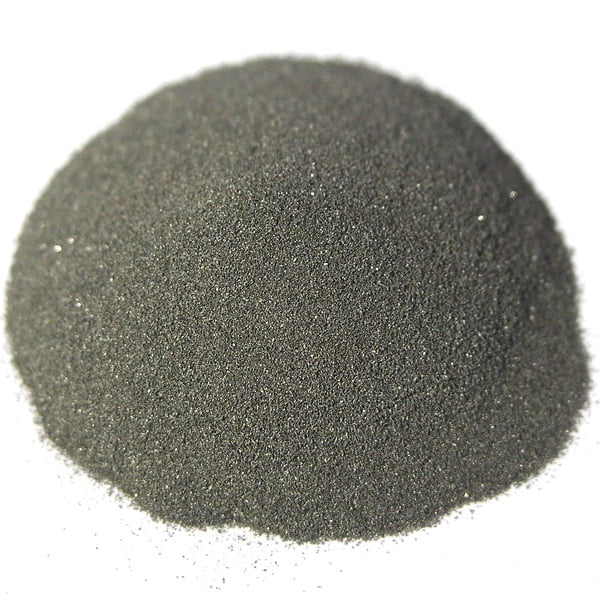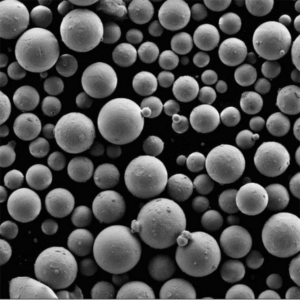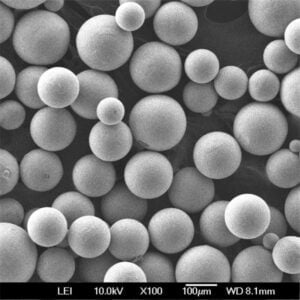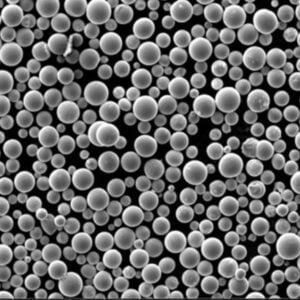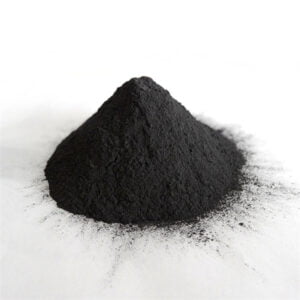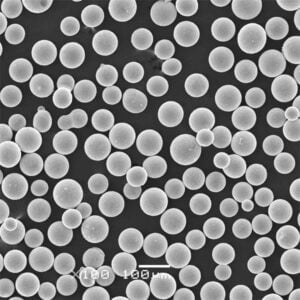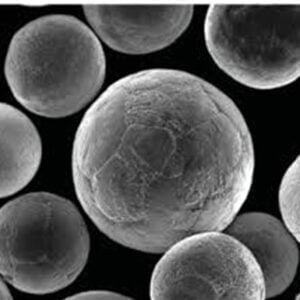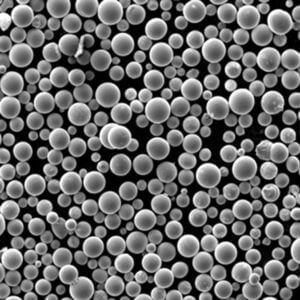Nickellegering 52 pulver
Nickel Alloy 52-pulver, även känt som Nicrofer 5220h eller 2.4631-pulver, är ett nickel-kromlegeringspulver som används för additiv tillverkning och 3D-utskrift av metall. Denna legering utmärker sig genom sina höga hållfasthetsegenskaper i kombination med enastående korrosions- och oxidationsbeständighet vid förhöjda temperaturer.
Låg MOQ
Tillhandahålla låg minsta orderkvantitet för att möta olika behov.
OEM & ODM
Tillhandahålla kundanpassade produkter och designtjänster för att tillgodose unika kundbehov.
Tillräckligt lager
Säkerställa snabb orderhantering och tillhandahålla tillförlitlig och effektiv service.
Kundtillfredsställelse
Tillhandahålla högkvalitativa produkter med kundnöjdhet i fokus.
dela denna produkt
Innehållsförteckning
Nickel Alloy 52-pulver, även känt som Nicrofer 5220h eller 2.4631-pulver, är ett nickel-kromlegeringspulver som används för additiv tillverkning och 3D-utskrift av metall. Denna legering utmärker sig genom sina höga hållfasthetsegenskaper i kombination med enastående korrosions- och oxidationsbeständighet vid förhöjda temperaturer.
Översikt över Nickel Alloy 52 Powder
Nickel Alloy 52-pulver har följande nyckelegenskaper:
- Sammansättning: Nickel, Krom, Järn, Molybden
- Hållfasthet och krypmotstånd vid höga temperaturer
- Utmärkt korrosions- och oxidationsbeständighet
- Används för additiv tillverkning, 3D-utskrift
- Tillämpningar inom flyg, kraftproduktion, kemisk bearbetning
Tabell 1: Nickellegering 52 pulveregenskaper
| Fastigheter | Detaljer |
|---|---|
| Sammansättning | Ni: Balans, Cr: 22%, Fe: 22%, Mo: 3% |
| Täthet | 8,3 g/cm3 |
| Smältpunkt | 1390°C |
| Ultimat draghållfasthet | 850-1000 MPa |
| Sträckgräns (vid 20°C) | 450 MPa |
| Töjning | 30-35% |
| Termisk ledningsförmåga | 11 W/mK |
| Termisk expansionskoefficient | 16 x 10-6/K |
| Korrosionsbeständighet | Utmärkt i oxiderande och reducerande miljöer upp till 1100°C |
| Oxideringsbeständighet | Utmärkt isotermisk oxidationsbeständighet i luft upp till 1100°C |
Tabell 2: Nickellegering 52 pulverstorlekar
| Pulverstorlek | Räckvidd | Partikelns form |
|---|---|---|
| Fin kvalitet | 15-45 μm | Sfäroid |
| Grov kvalitet | 45-150 μm | Sfäroid |
Tabell 3: Prissättning av nickellegering 52-pulver
| Pulverkvalitet | Prissättning |
|---|---|
| Fin kvalitet (<45 μm) | $100/kg |
| Grov kvalitet (45-150 μm) | $90/kg |
Sammansättning av nickellegering 52 pulver
Sammansättningen av Nickellegering 52 består huvudsakligen av nickel tillsammans med betydande mängder krom, järn och en liten andel molybden.
Nickel är huvudelementet som utgör balansen av kompositionen efter de andra legeringselementen. Nickel ger korrosionsbeständighet, duktilitet och mekaniska egenskaper vid hög temperatur.
Krom (Cr) utgör 22% av Nickel Alloy 52-pulver. Tillsatsen av krom förbättrar avsevärt oxidations- och korrosionsbeständigheten. Det ger också solid lösningsförstärkning.
Järn (Fe) läggs till upp till 22% för att förbättra hållfastheten vid hög temperatur genom förstärkning av fast lösning utan att försämra duktiliteten eller bearbetbarheten.
Molybden (Mo) utgör 3% av legeringssammansättningen. Molybden förbättrar ytterligare styrka vid förhöjd temperatur, krypmotstånd och legeringens stabilitet.
Denna optimerade kemiska sammansättning tillåter Nickel Alloy 52-pulver att visa en exceptionell kombination av hög temperaturhållfasthet, krypbeständighet, svetsbarhet och korrosions-/oxidationsbeständighet.
Egenskaper och kännetecken
Nickellegering 52 sticker ut på grund av sina imponerande mekaniska egenskaper i kombination med utmärkt högtemperaturkorrosions- och oxidationsbeständighet, som sammanfattas nedan:
Hög styrka: Nickel Alloy 52 pulver kan uppnå en draghållfasthet överstigande 1000 MPa och en sträckgräns över 450 MPa vid rumstemperatur. Detta innebär att tryckta delar har mycket hög hållfasthet som kan motstå höga mekaniska belastningar.
Bra duktilitet: Trots sin höga hållfasthet behåller Nickel Alloy 52 fortfarande en anständig töjning på 30-35% vilket tillåter viss flexibilitet och motståndskraft mot brott.
Utmärkt krypmotstånd: Legeringen har enastående krypbrottstyrka upp till 850°C tack vare sin fasta lösningsförstärkning och fällning. Detta tillåter hållbarhet mot deformation under ihållande belastning över tid.
Motståndskraftig mot termisk trötthet och cykling: Nickel Alloy 52-pulver tål snabba uppvärmnings- och kylcykler utan sprickbildning eller för tidigt fel. Detta är avgörande för komponenter som upplever fluktuerande temperaturer.
Korrosionsbeständig: Det höga innehållet av krom och molybden möjliggör exceptionell motståndskraft mot grop- och spaltkorrosion i oxiderande, neutrala och reducerande miljöer upp till temperaturer över 1000°C.
Oxidationsmotstånd: Ett mycket vidhäftande kromrikt oxidskikt skyddar materialet från oxidationsskador i luftmiljöer upp till 1100°C. Den motstår utbrytande oxidation även efter omfattande service.
Sammantaget gör kombinationen av styrka, duktilitet, krypmotstånd tillsammans med korrosions-/oxidationsbeständighet vid extrema temperaturer Nickel Alloy 52 till ett mångsidigt högpresterande material för metall AM och pulverbädd fusion 3D-utskrift.
Tillämpningar av nickellegering 52 pulver
Nickel Alloy 52 används i kritiska applikationer inom flyg-, kraftproduktion, kemisk bearbetning och andra hårda miljöer där förmågan att motstå extrema temperaturer och korrosion påverkar komponenternas livslängd och säkerhet.
Tabell 4: Tillämpningar av Nickel Alloy 52-pulver i olika sektorer
| Sektor | Komponenter | Begär förare |
|---|---|---|
| Flyg- och rymdindustrin | Turbinblad och skovlar, raketmunstycken, förbränningsliners | Hög temperaturhållfasthet för framdrivningssystem |
| Kraftproduktion | Värmeväxlare, fästelement | Korrosionsbeständighet för fossilbränsleanläggningar |
| Kemisk och petrokemisk | Ventiler, reaktorer, värmeväxlare | Oxidationsbeständighet för processer som involverar överhettad ånga |
| Marin | Avgaskomponenter | Korrosionsbeständighet i marina miljöer |
Några specifika applikationer inkluderar:
- Flygmotorkomponenter som blad, munstycken, hus och höljen
- Industriell gasturbin varma sektionsdelar
- Munstycken till raketmotorer
- Värmeväxlarrör för kemiska raffinaderier och offshoreplattformar
- Ventiler och processutrustning för frätande kemikalier
- Avgaskomponenter och turboladdare i marinmotorer
Möjligheten att 3D-skriva ut komplicerade, anpassningsbara geometrier som annars är omöjliga genom konventionell tillverkning utökar ytterligare potentiella tillämpningar av Nickel Alloy 52 över branscher.
Metall 3D-utskrift med nickellegering 52-pulver
Nickel Alloy 52-pulver används främst som råmaterial för pulverbäddsfusion (PBF)-baserade metalltillsatstillverkningsprocesser inklusive selektiv lasersmältning (SLM) och direkt metalllasersintring (DMLS).
Den typiska 3D-utskriftsprocessen innefattar:
- Spridning av ett enhetligt lager av Nickel Alloy 52-pulver på byggplattformen
- Selektivt smältande pulver för att stelna tvärsnitt med laser
- Sänkning av plattform och spridning av nytt lager pulver
- Upprepa lager för lager tills delen är klar
Tabell 5: Typiska 3D-utskriftsparametrar för Nickel Alloy 52-pulver
| Parameter | Detaljer |
|---|---|
| Skiktets tjocklek | 20-50 μm |
| Laserkraft | Upp till 500 W |
| Skanningshastighet | 750-3500 mm/s |
| Avstånd mellan luckor | 80-200 μm |
| Inert gas | Argon eller kväve |
Den utmärkta flytbarheten och höga densiteten hos Nickel Alloy 52-pulver möjliggör jämn spridbarhet tillsammans med god absorption och bibehållande av laserenergi vilket resulterar i stor tryckbarhet.
Korrekt glödgningsbehandlingar lindrar inre spänningar från den snabba stelningen som är inneboende i AM-processer, vilket gör att metalldelar uppfyller designkraven.
Jämfört med gjutning/smidning inkluderar fördelarna med additiv tillverkning av Nickel Alloy 52-komponenter:
- Komplexa geometrier är inte möjliga annars
- Minskade monteringsdelar genom konsoliderade konstruktioner
- Kortare utvecklingstider
- Lägre kostnader för mindre serieproduktion
- Höga styrka-till-vikt-förhållanden
- Utmärkt reproducerbarhet del till del
Begränsningar av metall AM behöver dock beaktas:
- Högre kostnad för stora produktionsvolymer
- Begränsad maximal kuvertstorlek för delar
- Ytterligare efterbearbetning kan krävas
- Anisotropa materialegenskaper
Sammantaget ger 3D-utskrift spelförändrande fördelar jämfört med konventionella tekniker för små nischapplikationer där faktorer som designkomplexitet, anpassning, kostnader och ledtider är kritiska.
Nickel Alloy 52 Powder Leverantörer
Några ledande globala leverantörer som erbjuder Nickel Alloy 52-pulver specifikt för tillverkning av metalltillsatser inkluderar:
Tabell 6: Nickel Alloy 52 pulvertillverkare
| Företag | Plats |
|---|---|
| Sandvik Osprey | Wales, Storbritannien |
| Snickare Tillsats | Virginia, USA |
| Höganäs | Sverige |
| Praxair | Indiana, USA |
| Sentient Jet | Kalifornien, USA |
Faktorer som skiljer pulverproducenter åt involverar kvalitetskontroll i:
- Kemisk sammansättning överensstämmer med strikta flyg- och rymdstandarder
- Sfäroidal partikelformfördelning
- Strikta hanteringsprocedurer för att förhindra kontaminering
- Utbud av partikelstorlekar tillgängliga
- Konsekvent pulvermorfologi från batch-till-batch
Så det är viktigt för 3D-utskriftsverkstäder att välja en pålitlig leverantör som tillhandahåller fullständig kvalitetssäkringscertifiering för Nickel Alloy 52-pulver anpassad till deras exakta byggprocessparametrar och krav.
Nickellegering 52 pulver Kostnader
Nickellegeringspulver är dyrare än konventionella rostfria stålpulver på grund av de patenterade kompositionerna som involverar högre nickel- och kromhalter.
Jämförelser med andra nickellegeringspulver
Nickel Alloy 52-pulver ger avsevärt bättre mekaniska egenskaper vid hög temperatur och korrosionsbeständighet jämfört med nickellegeringar på nybörjarnivå, men det är dyrare.
Tabell 7: Jämförelse av nickellegering 52 med andra nickellegeringspulver
| Legering | Styrka | Oxideringsbeständighet | Motståndskraft mot korrosion | Kostnad |
|---|---|---|---|---|
| Nickellegering 52 | Högsta | Upp till 1100°C | Utmärkt upp till 1100°C | Hög |
| Inconel 718 | Medium | Upp till 700°C | Måttlig upp till 700°C | Medium |
| Inconel 625 | Lägst | Upp till 980°C | Bra upp till 980°C | Låg |
Inconel 718 är ett billigare alternativ nickellegeringspulver, men det börjar mjukna över 650°C så det kan inte matcha 1100°C temperaturkapaciteten hos Nickel Alloy 52. Det har också lägre korrosions- och oxidationsbeständighet vid extrema temperaturer.
Inconel 625 ger bra oxidationsbeständighet vid kontinuerlig drift upp till 980°C. Den saknar dock tillräcklig hållfasthet vid hög temperatur för dynamiska belastningstillämpningar. Styrkan minskar snabbt över 700°C.
För extrema miljöer som involverar temperaturer över 1000°C tillsammans med varmkorrosion eller oxidation överträffar Nickel Alloy 52 klart alternativen till en ökad kostnadspremie. Men för mindre krävande applikationer kan Inconel 718 eller 625 ge tillräcklig prestanda till lägre pulverpriser.
Standarder och kvaliteter för nickellegering 52 pulver
Nickel Alloy 52-pulver för AM-applikationer tillverkas för att överensstämma med följande internationella materialspecifikationer:
- ASTM B466: Standard för gjutgods av nickel-krom-molybden-kolumbiumlegeringar
- AMS 5832: Nickellegering, korrosions- och värmebeständig, stänger, smide och ringar 52.5Ni – 22Cr – 22Fe – 3Mo
- DIN 2.4631 / NiCr22Fe19Mo3: Värmebeständig legeringsgjutning
Dessa specifikationer definierar acceptabla standarder för sammansättning, mekaniska egenskaper, kornstruktur, ytfinish och kvalitetsprocesser över globala leveranskedjor.
Tabell 8: Nickellegering 52 pulvercertifieringstyper
| Certifiering | Beskrivning |
|---|---|
| AS9100D Aerospace | Uppfyller kvalitetsstyrningsstandarder för luftvärdighet för flygkritiska flygtillämpningar |
| ISO 9001 | Verifierar processöverensstämmelse för kvalitetsledningssystem över produktion och leveranskedja |
| ISO 13485 | Bekräftar att strikta regler för medicintekniska produkter uppnås |
Ledande AM-pulvertillverkare av metall har sina Nickel Alloy 52-pulver certifierade enligt dessa specifikationer, vilket ger kunderna förtroende för att få defektfria högkvalitativa material lämpade för reglerade applikationer inom sektorer som flyg, försvar, energi och medicin.
Bästa praxis för utveckling av utskriftsparametrar
Eftersom Nickel Alloy 52 är relativt nytt för 3D-utskriftsapplikationer av metall, har effektiva utskriftsparametrar ännu inte standardiserats. Tryckerier bör samarbeta nära med sina pulverleverantörer och skrivartillverkare för att utveckla optimerade konstruktionsparametrar på prov-och-fel-basis med hänsyn till faktorer som:
- Laserkraft, skanningshastighet, luckavstånd
- Inställningar för inert gasflöde
- Förvärmning och bottenplattans uppvärmningstemperaturer
- Delorientering och stödstrukturer
- Glödgningscykler
Omfattande materialkaraktärisering är absolut nödvändig med hjälp av testgeometrier för att kvantifiera möjliga materialegenskaper för tillräcklig delprestanda. Mikrostruktur, hårdhetsmätningar, dragprovning och mikroskopi bör utföras för att jämföra provkupongbyggen innan du investerar i dyra slutproduktionskörningar.
Tabell 9: Riktlinjer för utveckling av utskriftsparametrar för Nickel Alloy 52
| Mål | Metod | Metrik | Mål |
|---|---|---|---|
| Densitetsoptimering | Parametermatrisexperiment | Relativ täthet | >99,5% |
| Reducering av reststress | Modifierade skanningsmönster, för-/eftervärmning | Deformation, XRD, modellering | Minimerad distorsion |
| Mekaniska egenskaper | Drag-/utmattningsprovning | UTS, sträckgräns, töjning % | Matcha målegenskaper |
| Mikrostrukturkontroll | Parametervariationer | Kornstorlek, fasanalys | Enhetliga, fina korn |
| Kostnadsminimering | Volympackningsanalys | Delkvantitet per konstruktion | Maximerad |
Med rigorösa testprotokoll som utnyttjar dessa bästa praxis, kan användare slå in optimala inställningar för att utnyttja den fulla potentialen hos Nickel Alloy 52 i sina specifika applikationer. Rådgör nära med experter från materialleverantörer, skrivar-OEM:er och tredjepartstjänsteleverantörer för att implementera sådana utvecklingsprocedurer effektivt.
VANLIGA FRÅGOR
Här är några vanliga vanliga frågor om 3D-utskrift av metall med Nickel Alloy 52-pulver:
Vilket partikelstorleksområde är bäst lämpat för laserpulverbäddsfusionstryck av Nickel Alloy 52?
Ett partikelstorleksområde mellan 15-45 mikron rekommenderas som det finaste pulvret för precisionsskanning av tunna lager. Grovare pulver från 45-100 mikron kan också ge bra tryckbarhet vid högre hastigheter genom att minska laserreflektiviteten.
Vilken typ av efterbearbetning krävs på AM Nickel Alloy 52 delar?
Som tryckt Nickel Alloy 52 har komponenter kvarvarande spänningar från den lokala smältningen och snabba stelnandet som är inneboende i 3D-utskrift. Spänningsavlastande värmebehandlingar mellan 700°C till 1000°C baserade på HIP eller vakuumugnglödgning är avgörande för att eliminera inre spänningar och förbättra de mekaniska egenskaperna. Ytterligare varm isostatisk pressning kan ytterligare maximera densiteten. Minimal bearbetning eller slipning kan också användas för att uppnå dimensionsnoggrannhet och önskad ytfinishkvalitet.
Är Nickel Alloy 52 kompatibel med multi-material utskrift eller legering med metall AM?
Ja, nickellegeringskompositer eller funktionellt graderade material som innehåller gradvisa övergångar från Nickel Alloy 52 till andra pulverlegeringar som rostfritt stål är ganska genomförbara utan omfattande materialvetenskapliga modifieringar. Bindemedelslegeringselementen och basnickelkompositionen tillåter lätt kompatibla legerings- eller blandningsmöjligheter inom AM-byggvolymer.
Kan du svetsa eller additivt reparera AM Nickel Alloy 52-komponenter?
Ja, pulverbäddsfusionstryckta Nickel Alloy 52-delar kan framgångsrikt svetsas eller repareras med hjälp av riktad energideponeringsbaserade AM-processer som lasermetalldeposition (LMD) eller elektronstråletillsatstillverkning. Kompatibla nickelfyllmaterial måste användas för att bygga upp slitna områden eller förena delkomponenter samtidigt som den önskade kemin, mekaniska egenskaperna och högtemperaturprestanda bibehålls.
Vilka designprinciper bör följas vid modellering av delar med Nickel Alloy 52 för metall AM?
Designriktlinjer för pulverbäddsfusionsprocesser måste implementeras som tar hänsyn till faktorer som optimal delorientering, minimala överhängsvinklar, tillräckliga väggtjocklekar, lämpliga stödstrukturer och övergångsradier för att möjliggöra ljuduppbyggnad. Att ta hänsyn till tillverkningsbegränsningar och potentiell efterbearbetning i förväg i CAD-modellen är nyckeln till att tillverka fullt fungerande Nickel Alloy 52-komponenter via 3D-utskrift.
Få det senaste priset
Om Met3DP
Produktkategori
HOT SALE
KONTAKTA OSS
Har du några frågor? Skicka oss meddelande nu! Vi kommer att betjäna din begäran med ett helt team efter att ha fått ditt meddelande.

Metallpulver för 3D-printing och additiv tillverkning
FÖRETAG
PRODUKT
cONTACT INFO
- Qingdao City, Shandong, Kina
- [email protected]
- [email protected]
- +86 19116340731






